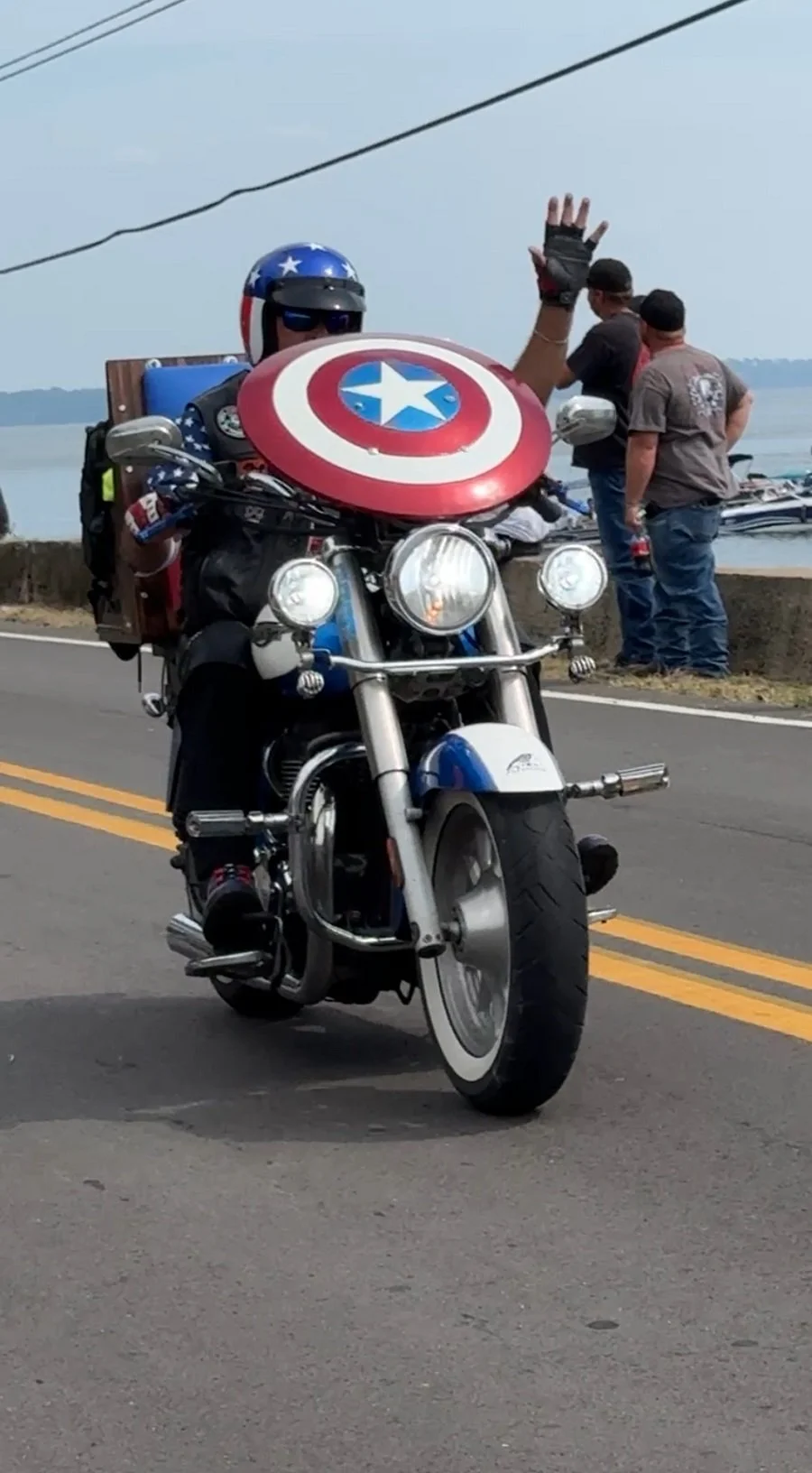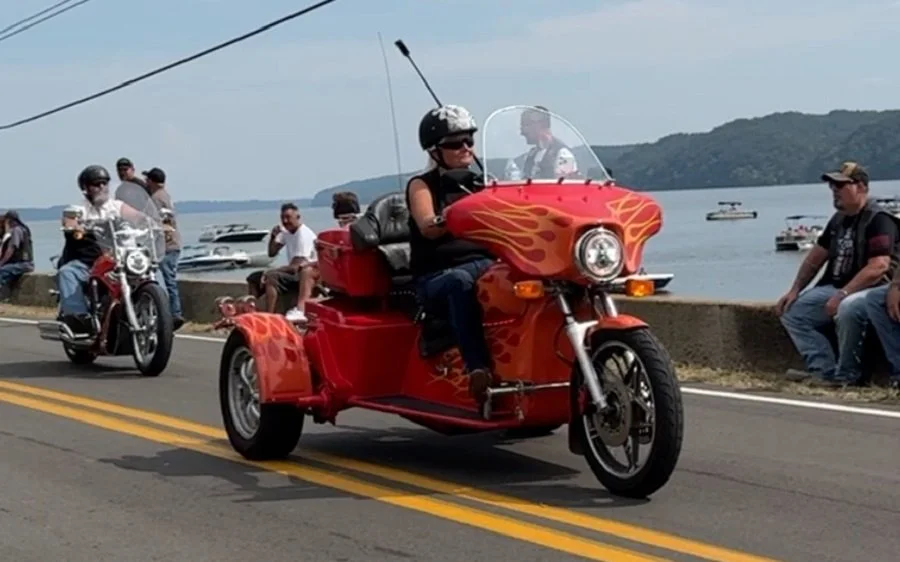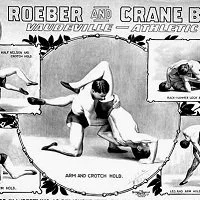By: “DragonKingKarl” Karl Stern (Patreon / Facebook / Email)
Webmaster & Writer - When It Was Cool
Podcast Host - Wrestling Observer, When It Was Cool
Author - DragonKingKarl’s Pioneer Era Pro Wrestling Omnibus: The Bible of the Pioneer Era of Pro Wrestling
The Trail of Tears and Waterloo, Alabama: History, Memory, and the Annual Commemorative Motorcycle Ride
The phrase “Trail of Tears” names a brutal policy and a long human story: the forced removals in the 1830s that displaced tens of thousands of Native people from their ancestral lands in the American Southeast to “Indian Territory” west of the Mississippi. That removal included multiple routes, many detachments, and enormous suffering and loss. In northwestern Alabama, Waterloo Landing on the Tennessee River became an important waypoint for detachments and a place of memory. Since the early 1990s, thousands of motorcyclists have ridden into Waterloo each autumn in a formal, organized commemoration that mixes ceremony, public education, and local stewardship of the site.
A concise history of removal (the 1830s context)
In 1830 Congress passed the Indian Removal Act, a law that authorized the president to negotiate relocation treaties and — in practice — to remove Native nations from valuable southeastern lands. The policy was driven by expanding white settlement, state actions to seize Native lands, and the discovery of gold on Cherokee lands; it unfolded amid legal battles, broken treaties, and growing federal enforcement.
The Cherokee experience is the best-known example. After years of legal resistance — including a Supreme Court decision favorable to Cherokee sovereignty (Worcester v. Georgia) — the federal government moved to expel the nation. In 1838–1839 detachments of Cherokee, and members of other southeastern tribes, were gathered, marched, or transported along multiple land and water routes toward present-day Oklahoma. The journeys occurred across different seasons and terrains; estimates place the number of Cherokee who died on these removals in the thousands, with widespread suffering from disease, exposure, malnutrition, and exhaustion.
Why Waterloo matters: the landing, camps, and routes
Waterloo (Lauderdale County) sits on the north bank of the Tennessee River (now Pickwick Lake). In the summer of 1838 detachments that could not proceed by river due to low water were marched overland from Ross’s Landing (Chattanooga) down the present-day US-72 corridor and encamped near what is now Waterloo before boarding boats or continuing west. That landing is one of many certified Trail of Tears sites in Alabama; it marks both a literal waypoint on the route and a place where historical memory and local preservation converge.
Local markers, retaining walls, and the interpretive features at the Waterloo landing help visitors visualize the movement of thousands of people and the logistical realities that shaped the detachments’ routes. These local memorials make the abstract scale of removal tangible: the river, the landing, the nearby hills and roads that stand where people once camped.
The Trail of Tears Commemorative Motorcycle Ride — origins and shape
Beginning in the early 1990s (the ride is now multi-decadal), the Trail of Tears Commemorative Motorcycle Ride (often organized through regional Trail of Tears corridor associations and local tourism partners) became an annual event that traces key portions of the historic removal routes in north Alabama and ends at Waterloo Landing. The ride commonly follows US-72 across northern Alabama, with staged departures (Bridgeport is a frequent start point) and an arrival festival in Waterloo featuring speakers, music, vendors, and often Native American cultural elements such as powwows or intertribal participation. The event draws riders from across the region and the country and has become one of the largest organized motorcycle rides in northern Alabama.
News coverage and local tourism listings show that each year the route and schedule are publicized in advance, and the ride routinely passes through cities like Florence and ends with ceremonies at the Waterloo landing. The event has grown into a regional tradition timed in mid-September and often described as both a “ride” and a mobile memorial.
How a motorcycle ride honors the Trail of Tears: multiple functions
The idea that a motorcycle rally could help honor a painful chapter of Indigenous history might seem counterintuitive at first, but the commemorative ride functions in several concrete and interlocking ways to remember the Trail of Tears:
Public remembrance and visibility. Thousands of riders moving together on a known historic corridor transforms memory into a visible, collective act. The sight and scale of the procession prompt curiosity and conversation among local residents and media, keeping the history in public view.
Pilgrimage and ceremonial closure. For many participants — riders, descendants, and local residents — arriving at Waterloo and participating in ceremonies or powwows becomes a pilgrim-like act of respect and reflection. Public gatherings at the landing create opportunities for prayer, music, and testimony.
Education and interpretation. The ride’s organizers and host communities often arrange interpretive materials, speakers, and signage. That programming helps translate a historic route into narratives people can understand: why Cherokee detachments were forced to move, where they were camped, and what the human costs were. Local museums and markers (and the NPS Trail of Tears site network) use these moments to reach new audiences.
Preservation and infrastructure support. The attention and visitor traffic associated with the ride support local investment in preservation — retaining walls at the landing, plaques, and riverwalk development that stabilize and protect the site for future generations. Fundraising, vendor activity, and tourism dollars tied to the event help underwrite that work.
Community bridging and reconciliation potential. When Native leaders, local officials, riders, and residents participate in the same public program, the ride can create a shared moment of acknowledgment. That does not erase historical injustice, but it opens an opportunity for listening, education, and collaborative stewardship of the site.
Respectful participation: what visitors should know and do
If you’re planning to attend the Waterloo commemorations or the motorcycle ride — whether as a rider or as a visitor — consider these guiding principles:
Learn the history ahead of time from reliable sources (NPS Trail of Tears materials, tribal resources, and established historical scholarship).
Treat Waterloo and other Trail of Tears sites as places of memory: be quiet and attentive during ceremonies; follow requests about photography and access; and respect any sacred or cultural activities that may be occurring.
Support site stewardship: donate or volunteer through local preservation groups, or patronize local museums and vendors whose proceeds go toward maintenance of interpretive spaces.
Listen to Indigenous voices: seek out Cherokee Nation resources and statements, and center Native perspectives when you report or share about the event.
Limits of commemoration and the work ahead
Commemoration is meaningful, but it cannot substitute for truth-telling, restitution, or the full recognition of tribal sovereignty and treaty rights. Events like the Trail of Tears motorcycle ride are valuable for visibility and stewardship, yet they should exist alongside deeper public education, support for Indigenous cultural programs, and policy work that addresses structural legacies of removal. Scholarship, museums, and tribal educational initiatives all have a role to play in moving from remembrance to ongoing responsibility.
Waterloo’s landing is at once a geographic fact and a mnemonic anchor: a place where routes intersected, lives were disrupted, and the river met the road. The Trail of Tears Commemorative Motorcycle Ride channels modern movement into a public act of remembrance — a noisy, visible, and surprisingly powerful form of pilgrimage that keeps a painful history in view while also helping preserve the physical place where that history unfolded. Thoughtful attendance, continued education, and meaningful engagement with tribal voices can help ensure that commemoration deepens into understanding and responsibility.
If you found this article interesting, please consider becoming a Patreon supporter. That is how When It Was Cool keeps our website and podcasts online, plus you get lots of bonus content including extra podcasts, articles, ebooks, and much more. Check out our Patreon Page to see what's up!





























